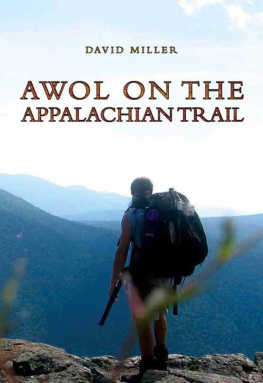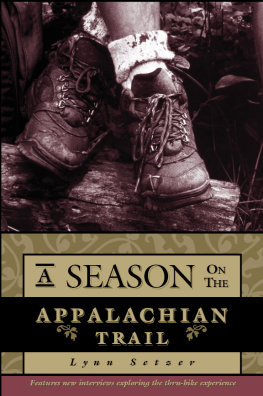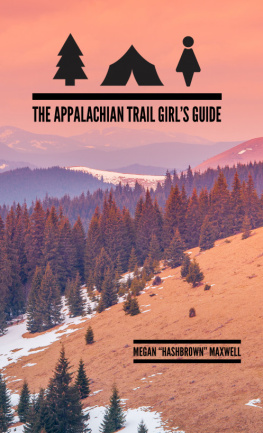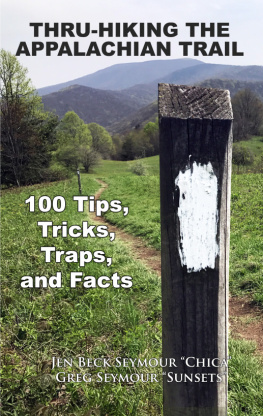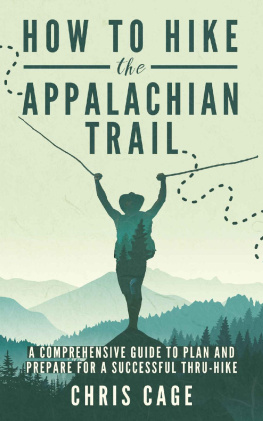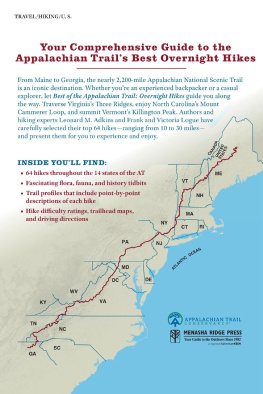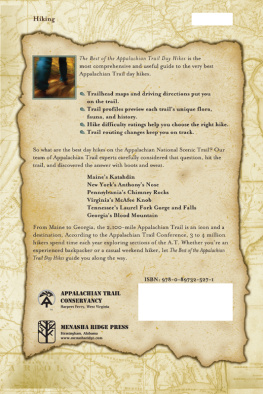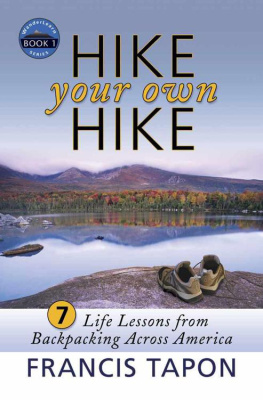AWOL ON THE APPALACHIAN TRAIL
DAVID MILLER

Text copyright (c) 2010 David Miller
All rights reserved
No part of this book may be reproduced, or stored in a retrieval system, or transmitted in any form or by any means, electronic, mechanical, photocopying, recording, or otherwise, without express written permission of the publisher.
Published by AmazonEncore
P.O. Box 400818
Las Vegas, NV 89140
ISBN: 978-1-935597-19-3

Introduction
In the spring of 2003, a few thousand people strapped on backpacks and headed out into the mountains of north Georgia. Their destination: Maine, over two thousand miles away. Eighty percent of them didn't make it.
The path they follow is called the Appalachian Trail, commonly referred to as the AT. It starts on the summit of Springer Mountain in Georgia and ends on top of Mount Katahdin in Maine.
Imagine drifting in a hot air balloon over the wooded hills of the Appalachian Mountain range, on a course that parallels the northeasterly slant of the eastern seacoast, low enough to peer down between the trees. You'll see a well-worn trail threading its way through trees, over rocks, over mountains, and down valleys. The AT doesn't skirt the mountaintops. Instead it takes a punitive path over every peak it can find. Few stretches of the trail form a straight line. In places, the trail curves wildly, seemingly with will, to buck off the hikers or ramp them over yet another hill. All this bobbing and weaving adds mileage. On foot the distance from Springer to Katahdin is 2,172 miles. Your balloon ride would be only thirteen hundred miles with significantly reduced risk of snakebite.
The trail passes through fourteen states. The mountains of Georgia and North Carolina are steep and densely wooded, immediately challenging hikers' resolve. The Great Smoky Mountains National Park, on the border of North Carolina and Tennessee, has more varieties of trees than there are in all of Europe. Virginia is less physically demanding than the first three states. Hikers celebrate upon reaching the town of Damascus, then move into Grayson Highlands, with open grassy ranges and wild ponies. By the middle of Virginia, hikers have walked off the enthusiasm they had at the start of their journey, and the end is still nowhere in sight. One quarter of the AT is in Virginia. The ten miles of trail in West Virginia are notable for passing through the headquarters of the Appalachian Trail Conference in Harpers Ferry. This is the emotional halfway point.
In western Maryland the trail clips through Civil War battlefields. Pennsylvania and New Jersey are infamous for rocks. Hikers have days in which they hardly ever touch soil. The AT in New York finds a corridor of woods between the mainland and Long Island. The cultured New England states of Connecticut, Massachusetts, and Vermont contrast with the haggard look of hikers who have endured months on the trail. The White Mountain National Forest in New Hampshire is one of the most scenic and hazardous sections of the trail. Sixteen miles of the trail are above tree line. The trail finishes fittingly with the longest ascent on the AT, a five-mile climb to the summit of Mount Katahdin in Maine.
The Appalachian Trail was conceived by Benton MacKaye in 1921. He envisioned an outdoor recreation area that city dwellers would use on weekends and vacations. For the most part, that is what the AT has become. The majority of people who set foot on the trail return to their homes at night.
What Benton MacKaye did not anticipate was anyone touched with the desire to walk continuously from end to end. No one did until 1948, when World War II veteran Earl Shaffer lugged his army rucksack from Georgia to Maine. Shaffer's accomplishment came to be known as a "thru-hike," and everyone who does the feat is called a "thru-hiker." This story is about the year I became one of them.
A thru-hike is an extended nomadic camping trip. Follow the path through the woods all day. Stop, set up camp, eat, and sleep. Get up, pack your things, and start walking again. At times the AT is steep enough to require hauling yourself up with your hands, but you won't need climbing skills or equipment. You carry your house (tent), your bed (sleeping bag), your stove, your food, and everything else you need until the next opportunity to resupply. If you need it, you have to carry it.
AT backpackers carry enough food to last three to five days. The food needs to be lightweight and durable. "Cooking" is adding hot water to something light and durable to make it edible. Hikers cherish the opportunity to eat real food. Opportunities come when the trail crosses a road within walking or hitching distance of a town. Hikers fill their bellies, clean up, and sometimes get medical care. They restock their packs with store-bought supplies, or supplies they've arranged to have mailed and held for them at post offices. Drinking water comes primarily from streams and springs along the trail. Most hikers will treat the water chemically or with a filter.
The towns know the hikers are coming, and hikers know every one of these towns: Hot Springs, North Carolina; Damascus, Virginia; Harpers Ferry, West Virginia; Duncannon, Pennsylvania; and Hanover, New Hampshire. Trail towns and the people who live near the trail are an integral part of the AT hiking experience.
Every hundred yards or so a tree or rock will be painted with a vertical bar of white--a "white blaze"--six inches tall and two inches wide, marking the AT. Hikers do get lost, but it is not common. More frequently, a hiker will take a break and resume hiking in the wrong direction, sometimes for miles. When you have a monumental number of miles to travel, repeating even a single mile is disheartening.
The typical thru-hike takes six months with an average of twelve miles walked per day. Hikers must reach Katahdin by October 15 when the park containing the mountain closes for the winter, so they usually start in March or April. Most thru-hikers go it alone. About three out of four hikers are men, but the percentage of women is increasing. The majority of thru-hikers have recently graduated or retired.
None of my peers could concisely articulate why they were doing a thru-hike. Most were motivated by a convergence of reasons. The time was right, they liked being outdoors, they were tired of their job (or their employer was tired of them), they wanted to lose weight, they had friends hiking, or they were inspired by another person's thru-hiking experience. The outdoor experience gives you a chance to get away from it all, have time for introspection, and to go many days in a row wearing the same unlaundered clothes on your unwashed body.
The exertion of carrying a pack up and down mountains day after day is incredibly fatiguing. You get hungry, you get rained on, your feet blister, and your legs ache. While hiking, you experience hardship, deprivation, drudgery, and pain, and the cooking stinks. The similarities to marriage don't end there. Some people love it, and many are committed to seeing it through.
Thru-hikers love to tell how steep the trail is and how much it rained because the difficulty of the endeavor is also part of the appeal. Many of the most gratifying experiences in life are those that are the most demanding. Seemingly in contradiction to the low probability of a successful thru-hike is the fact that anyone can thru-hike. A six-year-old has done it, and many grandmothers have done it. The trail was completed by Orient, a guide dog, and his master, Bill Irwin, who thru-hiked in 1990.

